Key takeaways:
- Stablecoins are designed to maintain a stable value by pegging to assets like fiat currencies, providing benefits of digital assets with reduced volatility.
- There are three main types of stablecoins: fiat-collateralized (backed by fiat reserves), crypto-collateralized (backed by other cryptocurrencies), and algorithmic (adjust supply based on demand).
- Using stablecoins can facilitate seamless transactions, serve as a safe entry point for new users, and often offer faster, cheaper transaction methods compared to traditional banking.
- Risks include regulatory uncertainty, lack of transparency regarding backing assets, and potential operational flaws in the technology supporting stablecoins.
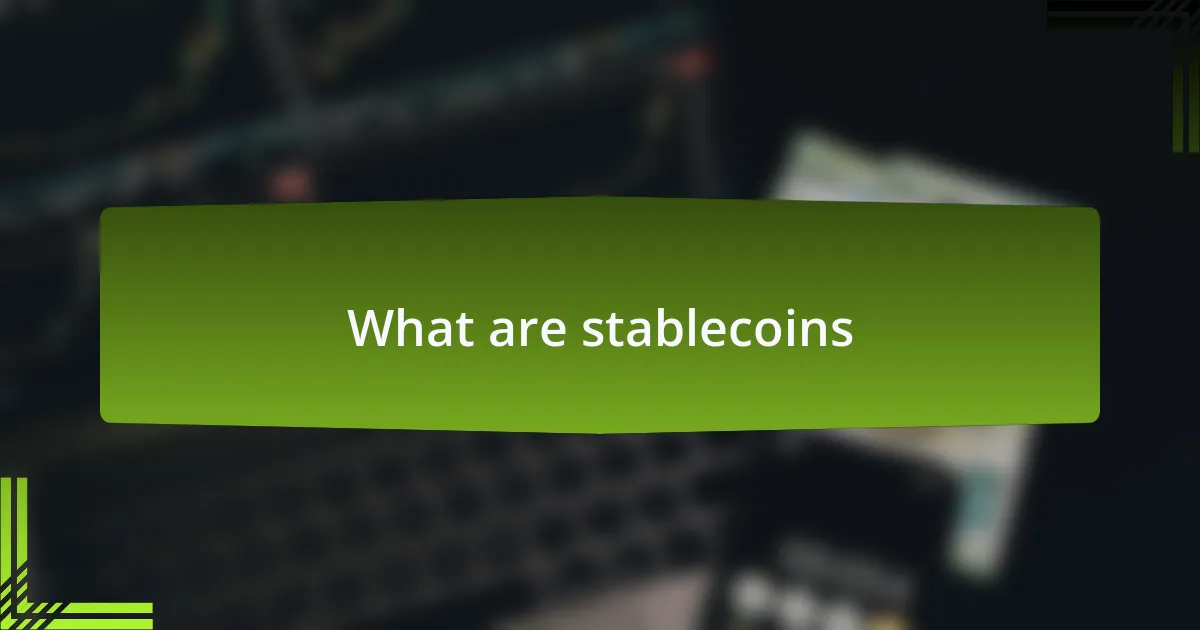
What are stablecoins
Stablecoins are a unique class of cryptocurrencies designed to maintain a stable value by pegging them to a reserve, often a fiat currency like the US dollar. I remember the first time I understood this concept; it was a lightbulb moment. I realized stablecoins could serve as a bridge for those hesitant to dive into the volatile world of crypto.
Unlike traditional cryptocurrencies, which can swing wildly in value, stablecoins aim to provide the best of both worlds: the benefits of digital assets and the stability of real-world currencies. This stability can make transactions smoother and more predictable. Have you ever found yourself frustrated while trying to complete a purchase due to price fluctuations? With stablecoins, that uncertainty simply fades away.
There are different types of stablecoins, including fiat-collateralized, crypto-collateralized, and algorithmic. Each comes with its own mechanism for maintaining stability. Personally, I find it fascinating to explore how each type operates — it’s like peeling back the layers of an onion to reveal the intricacies of the financial system housed within the crypto sphere.
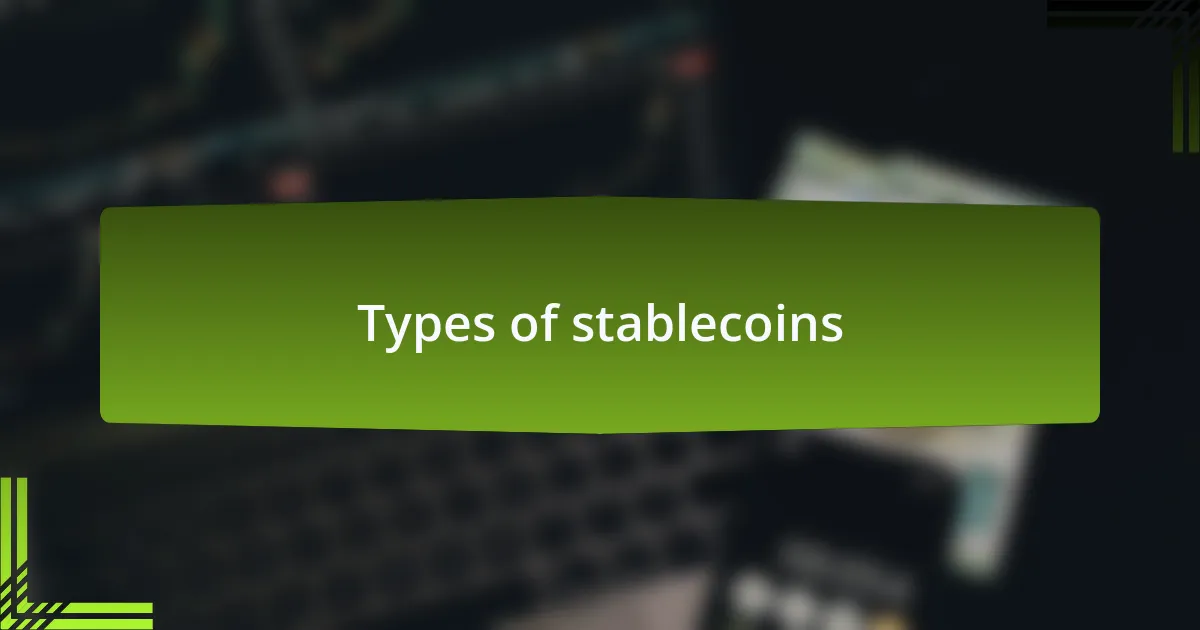
Types of stablecoins
When considering the types of stablecoins, fiat-collateralized stablecoins often come up first. These stablecoins are backed by actual reserves of fiat currency, typically held in a bank account. I recall my first interaction with a fiat-collateralized stablecoin; it was reassuring to see how it maintained a 1:1 ratio to the US dollar, providing me a sense of security as I ventured into crypto trading.
On the other hand, crypto-collateralized stablecoins can be more intriguing and complex. They use other cryptocurrencies as collateral to maintain their value, which means they can be more volatile than their fiat-backed counterparts. I remember feeling a thrill mixed with anxiety when I learned about one of these projects; the added layer of risk made it both exciting and daunting. How do you feel about relying on a fluctuating asset for stability?
Finally, there are algorithmic stablecoins, which rely on algorithms to regulate their supply, adjusting it based on demand. I find this concept particularly captivating because it embodies a different approach to stability—one that’s entirely dependent on technology rather than physical assets. It’s like witnessing a new evolution in finance; have we ventured into uncharted territory, or are we merely experimenting with a new set of rules? With each interaction, I’ve found myself pondering the future of these digital assets and what they might mean for our financial landscape.
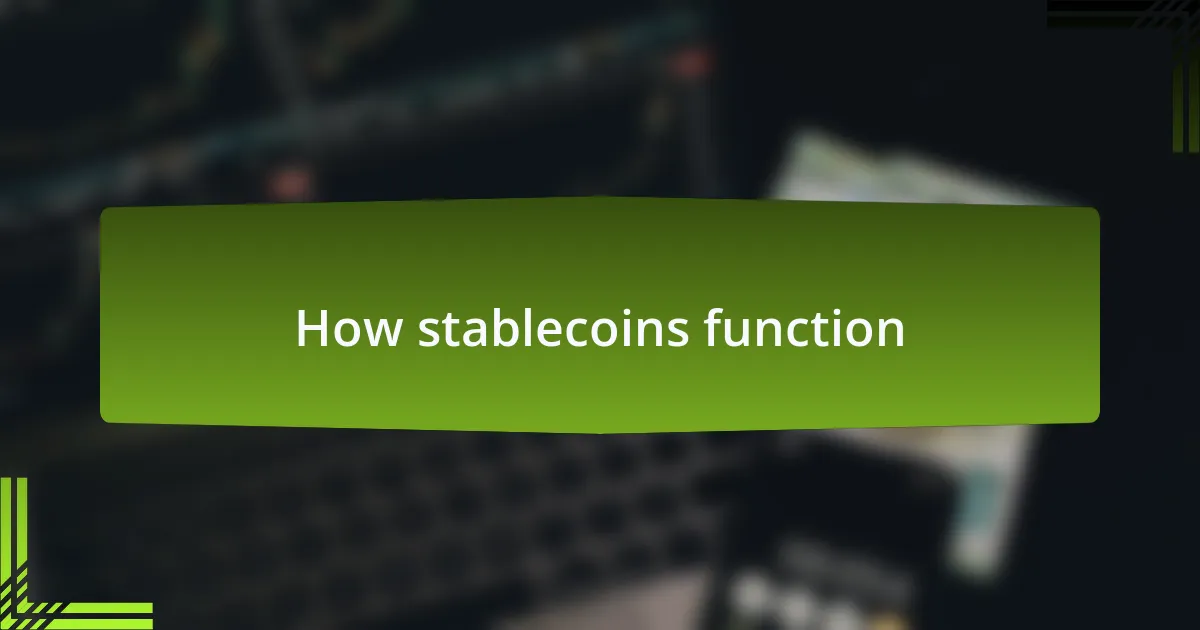
How stablecoins function
Stablecoins function by anchoring their value to a stable asset, typically fiat currency or other cryptocurrencies, which helps mitigate the volatility often associated with digital currencies. I vividly remember the first time I transferred a stablecoin, and it felt like I was holding a digital dollar that wouldn’t suddenly drop in value.
For fiat-collateralized stablecoins, the mechanism is straightforward; they are backed 1:1 by reserves in a bank, allowing users to confidently store and trade without fearing sudden price fluctuations. The reassurance I felt knowing my stablecoin was literally backed by cash gave me the confidence to explore other, more volatile cryptocurrencies without the constant worry of losing my capital.
In the case of crypto-collateralized stablecoins, they use a system of over-collateralization—where more value is locked up than the stablecoin issued—to maintain price stability. This model always has me reflecting on the balance: how much risk are we willing to take to achieve that sense of stability? Having dabbled in both systems, I can say that while fiat-backed stablecoins feel secure, the risk-reward equation of crypto-backed models presents a different thrill that I find hard to resist.

Benefits of using stablecoins
One of the most significant benefits of using stablecoins is their ability to facilitate seamless transactions without the fear of value loss. I still recall a time when I purchased goods with a stablecoin, and the experience was refreshing; it felt like using cash but in a digital format. No sudden dips in price meant I could focus on the item rather than worrying if my asset had just lost its value overnight.
Stablecoins also provide an excellent entry point for those new to cryptocurrency. I remember mentoring a friend who was hesitant about entering the crypto space due to its notorious volatility. I introduced him to stablecoins, and he found comfort in the stability they offered while still being able to participate in the ecosystem. It was like providing him with a safety net as he dipped his toes into a world that can often seem intimidating.
Moreover, transactions using stablecoins are often faster and cheaper than traditional banking methods. I experienced this firsthand when transferring funds internationally; the fees associated with traditional wire transfers can be gouging, whereas using a stablecoin for a cross-border transaction made sense financially and practically. This efficiency has made me appreciate not only the technological advancement of stablecoins but also the tangible savings they provide in my day-to-day dealings.
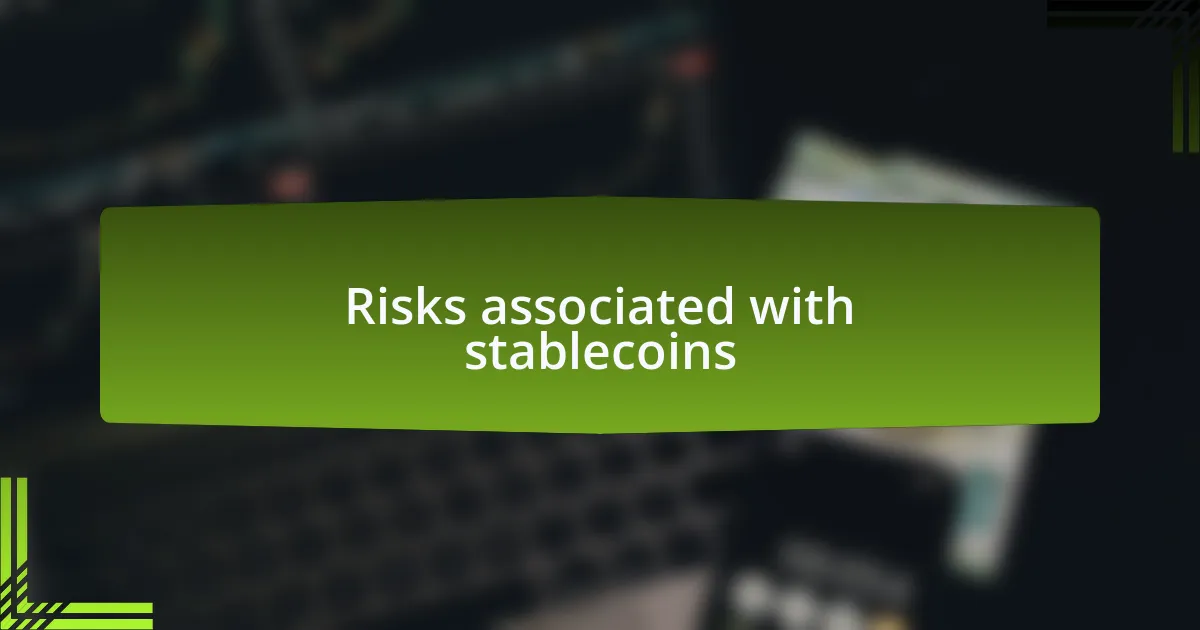
Risks associated with stablecoins
While stablecoins offer many advantages, they are not without their risks. One significant concern is regulatory uncertainty. I once shared a dinner with a group of crypto enthusiasts, and the conversation turned to how sudden regulatory changes could impact stablecoins. I realized that the regulatory landscape is constantly evolving, and a new law could dramatically affect the value or usability of these assets overnight.
Another risk lies in the backing of stablecoins. Some are backed by fiat currencies, while others are secured by crypto assets. I remember reading about a stablecoin that claimed to be fully backed by reserves, but when scrutiny came in, it turned out the transparency was lacking. This situation made me reflect on how essential it is to do thorough research and understand exactly what underpins a stablecoin before investing. If you’re counting on that stability, the last thing you want is to be left in the dark.
Additionally, there’s the potential for operational risks. One time, I attempted to transfer stablecoins to a friend, only to experience a glitch on the platform. That incident made me keenly aware of how technology can sometimes falter, creating delays and sometimes even loss of funds. So, even though stablecoins can provide a semblance of stability, the systems that support them can occasionally be anything but reliable. How often do we consider the technology behind our financial tools? It’s something I encourage everyone to be mindful of as they navigate the world of stablecoins.
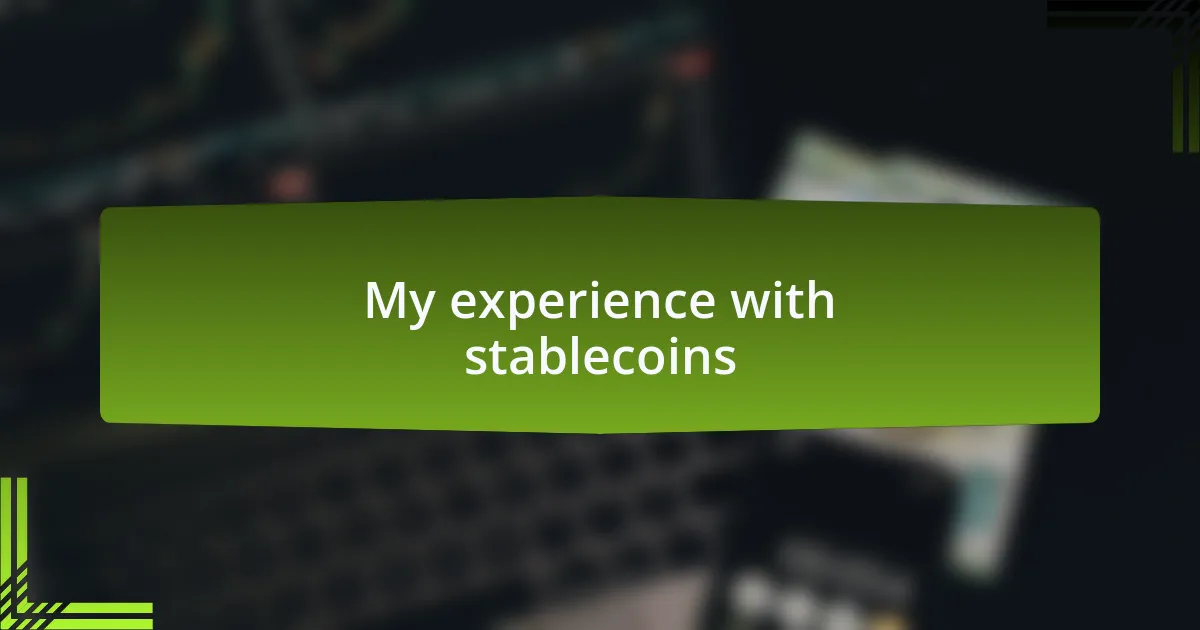
My experience with stablecoins
Navigating the world of stablecoins has been quite an eye-opener for me. I remember the first time I decided to use a stablecoin for a transaction; I felt this mix of excitement and apprehension. Would it really live up to its name? Seeing the value remain stable as I made my purchase was a relief, but it also made me think—what exactly does ‘stable’ mean in this ever-fluctuating market?
My experience was further enriched when I took a closer look at the different types of stablecoins. I dipped my toes into both fiat-backed and crypto-backed options, and honestly, it was like tasting two different dishes. Each had its own flavor and stability nuances. I vividly recall discussing these differences with a friend over coffee, and it struck me how critical it is to understand the inner workings of these currencies. How do we ensure our investments remain intact if we don’t grasp their fundamentals?
One of my most revealing moments came when I experienced the liquidity of a stablecoin firsthand during a market dip. I needed to cash out quickly, and I was pleasantly surprised by how smoothly the process went. It felt empowering to have that control in uncertain times. But, I also found myself asking: would that same ease exist if the market dynamics shifted? This experience underscored the importance of being prepared for all scenarios when dealing with stablecoins.